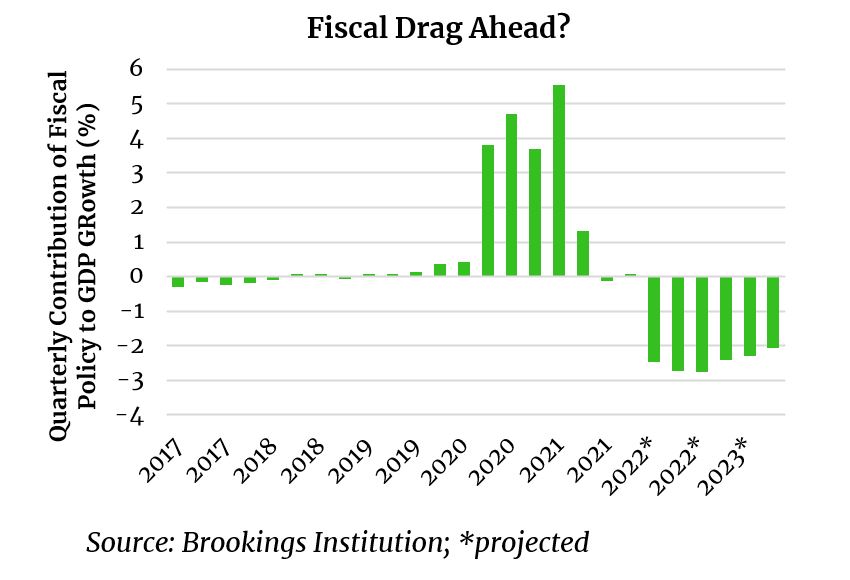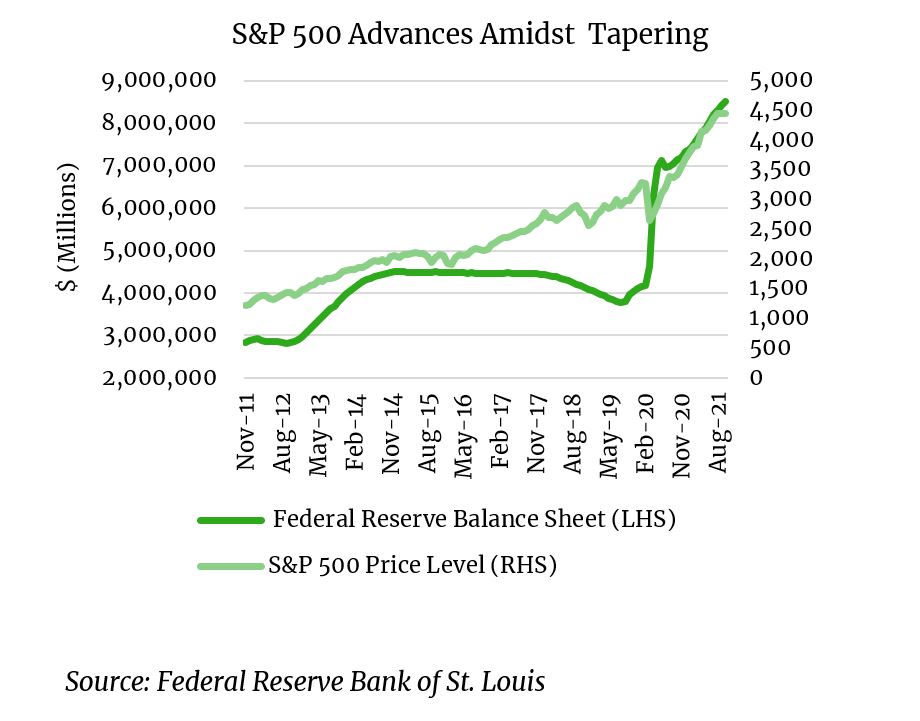Equities overcome inflationary pressures and prospects of tighter monetary policy
Key Observations
- Equity markets rebounded in October to new all-time highs.
- Treasury yields trended higher, leading to modest declines across most fixed income asset classes.
- S. and global central banks took initial steps toward tightening monetary policy (for historical perspective, markets produced positive returns when the Federal Reserve last shrank its balance sheet from 2015 through 2019).
October Market Recap
Late third quarter market volatility quickly abated in October. After U.S. large cap stocks declined in September (the first monthly decline in seven months and the first drawdown of more than 5 percent for the year), the S&P 500(1) advanced 7 percent in October, supported by resilient corporate fundamentals. Overcoming supply chain bottlenecks and inflationary pressures, 82 percent of S&P 500 companies beat earnings expectations(2) thus far in the reporting period – a near record high – with profits advancing 36.6 percent year-over-year(3). The rotation into value stocks that occurred in late September was short-lived, with the Russell 1000 Growth Index (8.7 percent) outgaining the Russell 1000 Value Index(4) (5.1 percent). Small-cap stocks (Russell 2000 Index(5)) returned 4.3 percent but have trailed the return of large cap stocks in seven of the last eight months. International markets (MSCI ACWI ex-U.S. Index(6)) returned 2.4 percent, as investors weighed diminishing concerns surrounding the potential default of Chinese property developer Evergrande along with the impact of energy shortages in China and the United Kingdom.
Returns were modestly lower across most fixed income asset classes for the month. Persistent inflationary pressures stemming from supply chain constraints and expectations for less accommodative monetary policy forced the U.S. 10-year Treasury yield to continue the ascent that began from its intra-year low of 1.19 percent on August 4, finishing the month at 1.55 percent. Meanwhile, the yield of two-year Treasuries doubled since mid-September to 0.48 percent, reflecting a rising probability of an initial rate hike in 2022(7). U.S. investment-grade bonds (Bloomberg U.S. Aggregate Bond TR) were nearly unchanged as the spreads of the highest-rated segments of corporate credit fell to levels below their pre-crisis lows , offsetting the impact of higher Treasury yields. Five-year inflation expectations rose to their highest level since 2006(8), leading Treasury Inflation-Protected Securities (Bloomberg U.S. Treasury U.S. TIPS TR) to advance 1.1 percent(9).
A Policy Transition
A pivot away from emergency levels of fiscal and monetary stimulus began in recent months. In September, Federal Reserve Chairman Jerome Powell indicated the Federal Reserve is likely to begin tapering its asset purchase program in November and now nine of 18 FOMC members expect a 2022 rate hike. Meanwhile, the effects of the emergency fiscal stimulus, resulting in the largest expansion of America’s federal budget deficit since World War II, will start to fade. According to the Hutchins Center on Fiscal and Monetary Policy at the Brookings Institution, overall government spending added significantly to economic growth in 2020 through the first quarter of this year; however, the forecast is for fiscal spending to potentially turn into a significant drag on growth by the fourth quarter of 2021 and through 2023(10).

Policy makers outside the U.S. were more aggressive in their response to rising inflation. Central banks in South Korea, Australia, Brazil, Russia, Mexico and Norway(11) recently moved official rates up from historical lows. Meanwhile, the Bank of England indicated it could raise rates by year-end, and the European Central Bank will likely announce the retirement of its Pandemic Emergency Purchase Program next March.

Equity markets displayed resilience throughout the last cycle of monetary policy tightening. The Federal Reserve reduced its balance sheet from a peak of $4.5 trillion in October 2014 to $3.8 trillion in August 2019(12), while raising the Federal Funds Target Rate from a range of 0.00-0.25 percent in late 2015 to a range of 2.25-2.50 percent through early 2019(13). Investors who remained invested through an initial spike in volatility in the early stages of policy normalization were rewarded with an average calendar year return for the S&P 500 of 12.5 percent from 2015 through 2019(14).
Market Outlook
Markets continue to weigh solid economic activity and corporate earnings against the potential impacts of inflationary pressures and a transition to less accommodative monetary and fiscal policy. Domestic equities ascended with historically low volatility to all-time highs after S&P 500 earnings expanded 94.2 percent year-over-year in the second quarter(15). Yet, sentiment based on a somewhat evolving macro-economic outlook caused abrupt swings in leadership within broader indices. With the recovery of S&P 500 earnings to above pre-crisis levels and valuations at elevated absolute levels, we expect equity markets will likely trend more in-line with earnings growth in coming years. Persistent shifts in style leadership are possible as investors grapple with the transition to more normal levels of economic activity and monetary policy. To this end, we recommend investors maintain a portfolio anchored by reasonable long-term return expectations with diversification across assets that may benefit from a variety of macro-economic conditions.
For more information, please reach out to any of the professionals at Cedar Cove Wealth Partners.
Footnotes
1. S&P 500 Total Return Index – Morningstar
2. “Expecting the Exceptional,” Northern Trust, October 22, 2021
3. “Earnings Insights” FactSet, October 29, 2021
4. Russell 1000 Growth and Russell 1000 Value Total Return Indexes – Morningstar
5. Russell 2000 Total Return Index – Morningstar
6. MSCI ACWI ex USA Net Return Index – Morningstar
7. US Department of the Treasury, Daily Treasury Yield Curve Rates, through October 29, 2021
8. Federal Reserve Bank of St. Louis, https://fred.stlouisfed.org/series/T5YIE
9. Bloomberg U.S. Aggregate Bond Total Return and Bloomberg U.S. Treasury U.S. TIPS Total Return Indexes – Morningstar
10. “Contribution of Fiscal Policy to Real GDP Growth,” Brookings Institution – Hutchins Center of Fiscal Impact, https://www.brookings.edu/interactives/hutchins-center-fiscal-impact-measure/
11. “Central Policy Rates,” BIS, https://www.bis.org/statistics/cbpol.htm
12. Federal Reserve Bank of St. Louis, https://fred.stlouisfed.org/series/WALCL
13. Federal Reserve Bank of St. Louis, https://fred.stlouisfed.org/series/DFEDTARU
14. FactSet
15. “U.S. Equity Market Attributes,” S&P, September 2021, https://www.spglobal.com/spdji/en/commentary/article/us-equities-market-attributes/
Advisory Persons of Thrivent provide advisory services under a practice name or “doing business as” name or may have their own legal business entities. However, advisory services are engaged exclusively through Thrivent Advisor Network, LLC, a registered investment adviser.
The material presented includes information and opinions provided by a party not related to Thrivent Advisor Network. It has been obtained from sources deemed reliable; but no independent verification has been made, nor is its accuracy or completeness guaranteed. The opinions expressed may not necessarily represent those of Thrivent Advisor Network or its affiliates. They are provided solely for information purposes and are not to be construed as solicitations or offers to buy or sell any products, securities or services. They also do not include all fees or expenses that may be incurred by investing in specific products. Past performance is no guarantee of future results. Investments will fluctuate and when redeemed may be worth more or less than when originally invested. You cannot invest directly in an index. The opinions expressed are subject to change as subsequent conditions vary. Thrivent Advisor Network and its affiliates accept no liability for loss or damage of any kind arising from the use of this information.
Different types of investments involve varying degrees of risk. Therefore, it should not be assumed that future performance of any specific investment or investment strategy will be profitable.
THRIVENT IS THE MARKETING NAME FOR THRIVENT FINANIAL FOR LUTHERANS. Investment advisory services offered through Thrivent Advisor Network, LLC., a registered investment adviser and a subsidiary of Thrivent.